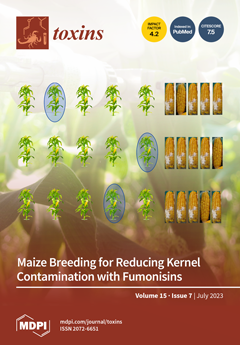The wide occurrence of resistance to Cry1A and Cry2A insecticidal toxins from
Bacillus thuringiensis (
Bt) in the corn earworm/bollworm
Helicoverpa zea (Boddie) leaves the Vip3A toxin produced during the vegetative stage of
Bt as the only fully active toxin expressed in
[...] Read more.
The wide occurrence of resistance to Cry1A and Cry2A insecticidal toxins from
Bacillus thuringiensis (
Bt) in the corn earworm/bollworm
Helicoverpa zea (Boddie) leaves the Vip3A toxin produced during the vegetative stage of
Bt as the only fully active toxin expressed in transgenic crops to control
H. zea in the U.S.A. During 2021, the first unexpected survival of
H. zea and injury (UXI) on a maize hybrid expressing Cry1A.105, Cry2Ab2, and Vip3Aa in Louisiana, U.S.A. were observed in two sentinel plots used for resistance monitoring. A follow-up intensive investigation was conducted with two
H. zea populations established from larvae collected from the two UXI plots. The main goal of this study was to reveal if the unexpected damage was due to resistance development in the insect to the
Bt toxins expressed in the maize hybrid. Diet-overlay bioassays showed that the two populations were highly resistant to Cry1A.105, moderately resistant to Cry2Ab2, but still highly susceptible to Vip3Aa when compared to a reference susceptible strain. In 10 d assays with detached ears, the larvae of the two UXI populations exhibited survival on ears expressing only Cry toxins but presented near 100% mortality on maize hybrids containing both
cry and
vip3A transgenes. Multiple field trials over three years demonstrated that natural
H. zea populations in Louisiana were highly resistant to maize expressing only Cry toxins but remained susceptible to all tested hybrids containing
cry and
vip3A genes. Altogether, the results of this study suggest that the observed UXIs in Louisiana were associated with a resistance to Cry toxins but were not due to a resistance to Vip3A. The possible causes of the UXIs are discussed. The results generated and procedures adopted in this study help in determining thresholds for defining UXIs, assessing resistance risks, and documenting field resistance.
Full article






